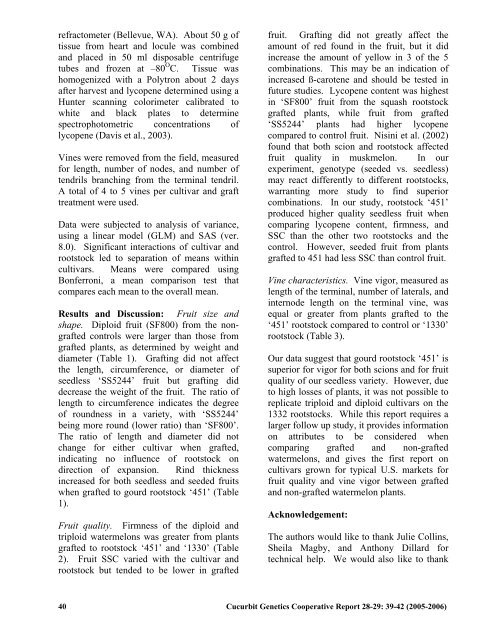Complete volume with articles 1 to 32 - Cucurbit Breeding - North ...
Complete volume with articles 1 to 32 - Cucurbit Breeding - North ...
Complete volume with articles 1 to 32 - Cucurbit Breeding - North ...
You also want an ePaper? Increase the reach of your titles
YUMPU automatically turns print PDFs into web optimized ePapers that Google loves.
efrac<strong>to</strong>meter (Bellevue, WA). About 50 g of<br />
tissue from heart and locule was combined<br />
and placed in 50 ml disposable centrifuge<br />
tubes and frozen at –80 O C. Tissue was<br />
homogenized <strong>with</strong> a Polytron about 2 days<br />
after harvest and lycopene determined using a<br />
Hunter scanning colorimeter calibrated <strong>to</strong><br />
white and black plates <strong>to</strong> determine<br />
spectropho<strong>to</strong>metric concentrations of<br />
lycopene (Davis et al., 2003).<br />
Vines were removed from the field, measured<br />
for length, number of nodes, and number of<br />
tendrils branching from the terminal tendril.<br />
A <strong>to</strong>tal of 4 <strong>to</strong> 5 vines per cultivar and graft<br />
treatment were used.<br />
Data were subjected <strong>to</strong> analysis of variance,<br />
using a linear model (GLM) and SAS (ver.<br />
8.0). Significant interactions of cultivar and<br />
roots<strong>to</strong>ck led <strong>to</strong> separation of means <strong>with</strong>in<br />
cultivars. Means were compared using<br />
Bonferroni, a mean comparison test that<br />
compares each mean <strong>to</strong> the overall mean.<br />
Results and Discussion: Fruit size and<br />
shape. Diploid fruit (SF800) from the nongrafted<br />
controls were larger than those from<br />
grafted plants, as determined by weight and<br />
diameter (Table 1). Grafting did not affect<br />
the length, circumference, or diameter of<br />
seedless ‘SS5244’ fruit but grafting did<br />
decrease the weight of the fruit. The ratio of<br />
length <strong>to</strong> circumference indicates the degree<br />
of roundness in a variety, <strong>with</strong> ‘SS5244’<br />
being more round (lower ratio) than ‘SF800’.<br />
The ratio of length and diameter did not<br />
change for either cultivar when grafted,<br />
indicating no influence of roots<strong>to</strong>ck on<br />
direction of expansion. Rind thickness<br />
increased for both seedless and seeded fruits<br />
when grafted <strong>to</strong> gourd roots<strong>to</strong>ck ‘451’ (Table<br />
1).<br />
Fruit quality. Firmness of the diploid and<br />
triploid watermelons was greater from plants<br />
grafted <strong>to</strong> roots<strong>to</strong>ck ‘451’ and ‘1330’ (Table<br />
2). Fruit SSC varied <strong>with</strong> the cultivar and<br />
roots<strong>to</strong>ck but tended <strong>to</strong> be lower in grafted<br />
fruit. Grafting did not greatly affect the<br />
amount of red found in the fruit, but it did<br />
increase the amount of yellow in 3 of the 5<br />
combinations. This may be an indication of<br />
increased ß-carotene and should be tested in<br />
future studies. Lycopene content was highest<br />
in ‘SF800’ fruit from the squash roots<strong>to</strong>ck<br />
grafted plants, while fruit from grafted<br />
‘SS5244’ plants had higher lycopene<br />
compared <strong>to</strong> control fruit. Nisini et al. (2002)<br />
found that both scion and roots<strong>to</strong>ck affected<br />
fruit quality in muskmelon. In our<br />
experiment, genotype (seeded vs. seedless)<br />
may react differently <strong>to</strong> different roots<strong>to</strong>cks,<br />
warranting more study <strong>to</strong> find superior<br />
combinations. In our study, roots<strong>to</strong>ck ‘451’<br />
produced higher quality seedless fruit when<br />
comparing lycopene content, firmness, and<br />
SSC than the other two roots<strong>to</strong>cks and the<br />
control. However, seeded fruit from plants<br />
grafted <strong>to</strong> 451 had less SSC than control fruit.<br />
Vine characteristics. Vine vigor, measured as<br />
length of the terminal, number of laterals, and<br />
internode length on the terminal vine, was<br />
equal or greater from plants grafted <strong>to</strong> the<br />
‘451’ roots<strong>to</strong>ck compared <strong>to</strong> control or ‘1330’<br />
roots<strong>to</strong>ck (Table 3).<br />
Our data suggest that gourd roots<strong>to</strong>ck ‘451’ is<br />
superior for vigor for both scions and for fruit<br />
quality of our seedless variety. However, due<br />
<strong>to</strong> high losses of plants, it was not possible <strong>to</strong><br />
replicate triploid and diploid cultivars on the<br />
13<strong>32</strong> roots<strong>to</strong>cks. While this report requires a<br />
larger follow up study, it provides information<br />
on attributes <strong>to</strong> be considered when<br />
comparing grafted and non-grafted<br />
watermelons, and gives the first report on<br />
cultivars grown for typical U.S. markets for<br />
fruit quality and vine vigor between grafted<br />
and non-grafted watermelon plants.<br />
Acknowledgement:<br />
The authors would like <strong>to</strong> thank Julie Collins,<br />
Sheila Magby, and Anthony Dillard for<br />
technical help. We would also like <strong>to</strong> thank<br />
40 <strong>Cucurbit</strong> Genetics Cooperative Report 28-29: 39-42 (2005-2006)
















